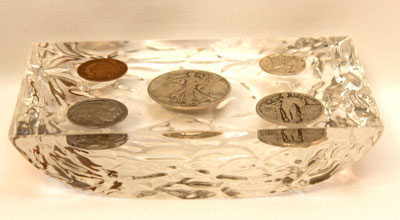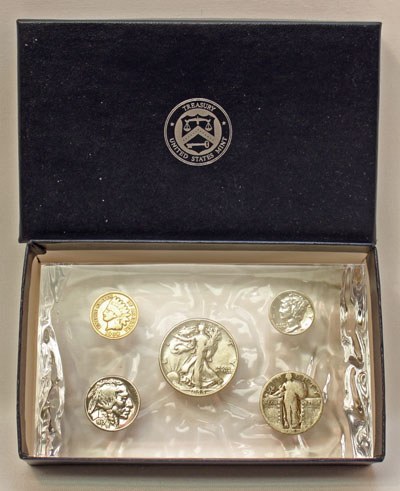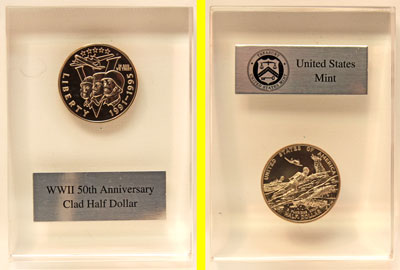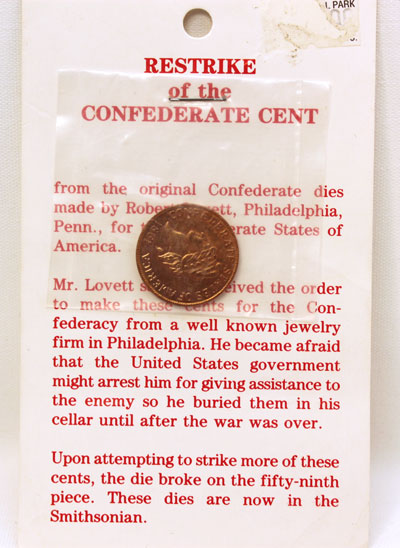© Copyright Atlanta Coin Expositions, 2008-2025. All Rights Reserved.
Several of the links on the pages within this web site go to affiliate vendors.
A vendor affiliation can mean a small monetary compensation to the web site owner at no additional cost to you.
Several of the links on the pages within this web site go to affiliate vendors.
A vendor affiliation can mean a small monetary compensation to the web site owner at no additional cost to you.
Coin Show
Information
Shop
General
Next Monthly Coin Show
Old Coins in Acrylic
World War II Commemorative Half Dollar Coin
Old San Francisco Mint Medal
Coin Show - Monthly Notes from December 2018
Russian Bayonet
It was a cold, rainy day, but the December 2018 Greater Atlanta Coin Show welcomed many guests to the bourse filled numismatics and other collectibles in the dealers' showcases.
Thank you to everyone for making this last show of 2018 and all of the other monthly coin shows an interesting and fun place to visit one Sunday each month.
We appreciate all the visitors, all the dealers, our security and the hotel's staff for helping make the show a success.
As for the hotel, the show shared the conference area with several churches, which frequently happens. Later in the day, the facility hosted Christmas parties, too.
Thank you to everyone for making this last show of 2018 and all of the other monthly coin shows an interesting and fun place to visit one Sunday each month.
We appreciate all the visitors, all the dealers, our security and the hotel's staff for helping make the show a success.
As for the hotel, the show shared the conference area with several churches, which frequently happens. Later in the day, the facility hosted Christmas parties, too.
This month, thankfully, the weather provided just cold and blustery rain. In the north Georgia mountains and further north, snow, sleet and ice made travel dangerous much like we encountered for the December 2017 show.
But, people still came to browse, buy and sell among the coins, currency, bullion and other interesting items.
Many people looked for bullion, some silver, some gold. Others looked for items for their gift list, or maybe even as a gift for themselves.
But, people still came to browse, buy and sell among the coins, currency, bullion and other interesting items.
Many people looked for bullion, some silver, some gold. Others looked for items for their gift list, or maybe even as a gift for themselves.
Some looked for specific coins or sets for certain years to commemorate birth years or other significant events.
Let's take a virtual look at just a few of the items on the December bourse.
Let's take a virtual look at just a few of the items on the December bourse.

Our first example is not part of the numismatic family, however it is a collectible.
This Russian bayonet was used with a Mosin Nagant M1891/30 rifle.
The Russian Mosin Nagant Forum describes the gun:
This Russian bayonet was used with a Mosin Nagant M1891/30 rifle.
The Russian Mosin Nagant Forum describes the gun:

"The Model 1891/30 Rifle was commissioned by the Revolutionary Military Council of the Workers' and Peasants' Red Army. Early in 1924 a committee consisting of Ye. K. Kabakov and I. A. Komaritskii, began work on modernizing the M1891, using the dragoon model as a basis. The first trial rifles were made in 1927 and by 1930 a new design had been agreed upon, which was standardized on 28 April as the "Rifle Model 1891/30." Production of the M1891/30 began on 10 June 1930 at Tula and Izhevsk and ceased at Tula in the spring or summer of 1942. Izhevsk discontinued production in 1944."
From 1930 through 1944, the two locations manufactured over 12.6 million of the M91/30 rifles with just over 100,000 produced in the first year and over three million in 1942.
Wonder where this bayonet saw action. Odds are it was used in World War II, but where?
Just another interesting item that can be found on the bourse.
From 1930 through 1944, the two locations manufactured over 12.6 million of the M91/30 rifles with just over 100,000 produced in the first year and over three million in 1942.
Wonder where this bayonet saw action. Odds are it was used in World War II, but where?
Just another interesting item that can be found on the bourse.

This set of old coins contains half dollar, quarter, dime, nickel and cent coins, however the coins are from different years.
The Indian head cent is from 1908 while the Buffalo nickel is from 1937. The Mercury dime is from 1944 as is the Walking liberty half dollar. The Standing liberty quarter is the most worn and appears to be from 1929.
Interestingly, the box holding the set shows the Treasury United States Mint seal on the top. Also, the color of the box is a familiar US Mint dark blue.
But, did the US Mint produce this set?
In the past, some coin dealers have encased coins in acrylic for special promotions, however they cannot use the US Mint seal.
Oddly, the coins in the set are from different years. Perhaps they are similar to sets that have been promoted as "Americana" coins.
The Indian head cent is from 1908 while the Buffalo nickel is from 1937. The Mercury dime is from 1944 as is the Walking liberty half dollar. The Standing liberty quarter is the most worn and appears to be from 1929.
Interestingly, the box holding the set shows the Treasury United States Mint seal on the top. Also, the color of the box is a familiar US Mint dark blue.
But, did the US Mint produce this set?
In the past, some coin dealers have encased coins in acrylic for special promotions, however they cannot use the US Mint seal.
Oddly, the coins in the set are from different years. Perhaps they are similar to sets that have been promoted as "Americana" coins.
The production years of the coins vary and do not all overlap. For example:
Indian Head Cent: 1859-1909 (1908)
Buffalo Nickel: 1913-1938 (1937)
Mercury Dime: 1916-1945 (1944)
Standing Liberty Quarter: 1916-1930 (1929)
Walking Liberty Half Dollar: 1916-1947 (1944)
But, look, isn't it interesting that four of the coins are from the next to the last year of production.
Numismatic purists are dismayed by coins placed in acrylic, but for a fun display, this set is a good example of early 20th century coins.
Indian Head Cent: 1859-1909 (1908)
Buffalo Nickel: 1913-1938 (1937)
Mercury Dime: 1916-1945 (1944)
Standing Liberty Quarter: 1916-1930 (1929)
Walking Liberty Half Dollar: 1916-1947 (1944)
But, look, isn't it interesting that four of the coins are from the next to the last year of production.
Numismatic purists are dismayed by coins placed in acrylic, but for a fun display, this set is a good example of early 20th century coins.


Here's another example of collectible coins in acrylic.
This one is a World War II 50th Anniversary Clad Half Dollar Coin. Not only does the outer box have the US Mint details, but the acrylic also contains a silver-colored metal label with the US Mint seal on the reverse.
The box also includes the Certificate of Authenticity for the coin.
Doing a little research online finds discussions that the US Mint provides coins encased in acrylic as gifts to employees and dignitaries.
This one is a World War II 50th Anniversary Clad Half Dollar Coin. Not only does the outer box have the US Mint details, but the acrylic also contains a silver-colored metal label with the US Mint seal on the reverse.
The box also includes the Certificate of Authenticity for the coin.
Doing a little research online finds discussions that the US Mint provides coins encased in acrylic as gifts to employees and dignitaries.
However, a recent query to US Mint Support about coins in acrylic yielded the following reply:
"We appreciate your interest in United States Mint products; however, the United States Mint does not package the particular product as noted in your inquiry and are unable to assist you concerning it."
But, could it be that the US Mint support person is not knowledgeable about older products?
The gentleman who owned this particular item said that he ordered it directly from the US Mint.
Perhaps not a perfect numismatic item, but it is a nice keepsake for a World War II remembrance.
"We appreciate your interest in United States Mint products; however, the United States Mint does not package the particular product as noted in your inquiry and are unable to assist you concerning it."
But, could it be that the US Mint support person is not knowledgeable about older products?
The gentleman who owned this particular item said that he ordered it directly from the US Mint.
Perhaps not a perfect numismatic item, but it is a nice keepsake for a World War II remembrance.


The next item is not a coin but a medal highlighting the completion of the Old San Francisco Mint's restoration.
This medal was a US Mint item as described in this Press Release from October 29, 1976:
"A new Old San Francisco Mint souvenir medal, dated to mark the completion of the restoration of the national landmark building, is part of the celebration planned to coincide with the public opening of the display of the 1907 Indian Head $20 gold pattern at 10 a.m., Tuesday, November 9, 1976, at the old Mint, Mrs. Mary Brooks, Director of the Mint, announced today.
This medal was a US Mint item as described in this Press Release from October 29, 1976:
"A new Old San Francisco Mint souvenir medal, dated to mark the completion of the restoration of the national landmark building, is part of the celebration planned to coincide with the public opening of the display of the 1907 Indian Head $20 gold pattern at 10 a.m., Tuesday, November 9, 1976, at the old Mint, Mrs. Mary Brooks, Director of the Mint, announced today.
"The design of the bronze medal, 1-1/2″ in diameter, is to feature a portrait of Mint Director Mary Brooks on the obverse and a view of the Old Mint and the date November 9, 1976, on the reverse.
"Visitors may purchase bronze blanks for $1.00 and strike their own medal on the specially-automated 1869 press in the Old Mint Museum-or purchase the new medal over-the-counter at the Old Mint.
"A limit of 10,000 specimens of the new souvenir medal has been set and they will be available for sale only at the Old Mint in San Francisco. No mail orders will be accepted.
"The Old Mint Museum, Fifth and Mission Streets, San Francisco, California, is open to the public Tuesday through Saturdays, 10 a.m. to 4 p.m. There is no admission charge."
This item is another fascinating view into the history of the US Mint and a fine example of the medallic arts.
"Visitors may purchase bronze blanks for $1.00 and strike their own medal on the specially-automated 1869 press in the Old Mint Museum-or purchase the new medal over-the-counter at the Old Mint.
"A limit of 10,000 specimens of the new souvenir medal has been set and they will be available for sale only at the Old Mint in San Francisco. No mail orders will be accepted.
"The Old Mint Museum, Fifth and Mission Streets, San Francisco, California, is open to the public Tuesday through Saturdays, 10 a.m. to 4 p.m. There is no admission charge."
This item is another fascinating view into the history of the US Mint and a fine example of the medallic arts.
Restrike of the Confederate Cent


The last specimen for this month is a Restrike of a Confederate Coin.
The paper reads:
"Restrike of the Confederate Cent from the original Confederate dies made by Robert Lovett, Philadelphia, Pennsylvania, for the Confederate States of America.
"Mr. Lovett said he received the order to make these cents for the Confederacy from a well known jewelry firm in Philadelphia. He became afraid that the United States government might arrest him for giving assistance to the enemy so he buried them in his cellar until after the war was over.
"Upon attempting to strike more of these cents, the die broke on the fifty-ninth piece. These dies are now in the Smithsonian."
But, is this a real restrike or a copy of a restrike?
More information can be found on coinauctionshelp.com:
The paper reads:
"Restrike of the Confederate Cent from the original Confederate dies made by Robert Lovett, Philadelphia, Pennsylvania, for the Confederate States of America.
"Mr. Lovett said he received the order to make these cents for the Confederacy from a well known jewelry firm in Philadelphia. He became afraid that the United States government might arrest him for giving assistance to the enemy so he buried them in his cellar until after the war was over.
"Upon attempting to strike more of these cents, the die broke on the fifty-ninth piece. These dies are now in the Smithsonian."
But, is this a real restrike or a copy of a restrike?
More information can be found on coinauctionshelp.com:
"Robert Lovett Jr. a die designer and die sinker, of Philadelphia, was approached by Confederate States agents to design a coinage for CSA (Confederate States Of America). He designed the One Cent with a “French Head” and struck 12 original pieces. However the Civil War commenced and he distanced himself from the Confederacy for fear of being charged with treason.
"After the war John W. Hasteltine bought the dies from Lovett and in 1874 struck a reported 55 pieces in copper and some in gold and silver, but none in copper/nickel. Lovett struck his originals in copper/nickel, and Hasteltine didn’t use this alloy, so as not to be confused with the original 12 “Confederate” One Cents.
"Robert Bashlow and David Laties bought the Confederate one cent dies from John Ford and struck the coins using the defaced dies in 1962. The evidence on the coins of the dies being defaced is a hallmark for Blashlow restrikes. The coins were minted in copper, gold, nickel/silver, aluminum, red fiber, lead, platinum, tin, zinc with gold being the rarest at only three pieces struck, but less than fifty of the other metals.
"There’s a lot of controversy about the various C.S.A. restrikes and most of the controversy surrounds how many were minted. So the above article is subject to change if more factual evidence presents itself. So do your research and don’t take any one source as the gospel on Confederate coins and restrikes."
Even if this is a copy, the specimen showcases history of over 150 years ago.
"There’s a lot of controversy about the various C.S.A. restrikes and most of the controversy surrounds how many were minted. So the above article is subject to change if more factual evidence presents itself. So do your research and don’t take any one source as the gospel on Confederate coins and restrikes."
Even if this is a copy, the specimen showcases history of over 150 years ago.
This odd variety of collectibles gives examples of just a few of the items, not just coins, that can be found on the bourse each month.
Of course, it is a "coin" show with a variety of coins, currency, bullion and other money related or investment type items.
But visitors can also find other collectibles such as medals, small antique items, precious and semi-precious stones and whatever trips the dealers' fancy in the displays as well.
Join us in the new year to buy, sell or just browse among the showcases at the next monthly coin show.
Mark your calendars and visit the next Greater Atlanta Coin Show on Sunday, January 13, 2019, in the Joe Mack Wilson ballroom to meet the dealers and see the collectibles on display.
Of course, it is a "coin" show with a variety of coins, currency, bullion and other money related or investment type items.
But visitors can also find other collectibles such as medals, small antique items, precious and semi-precious stones and whatever trips the dealers' fancy in the displays as well.
Join us in the new year to buy, sell or just browse among the showcases at the next monthly coin show.
Mark your calendars and visit the next Greater Atlanta Coin Show on Sunday, January 13, 2019, in the Joe Mack Wilson ballroom to meet the dealers and see the collectibles on display.

